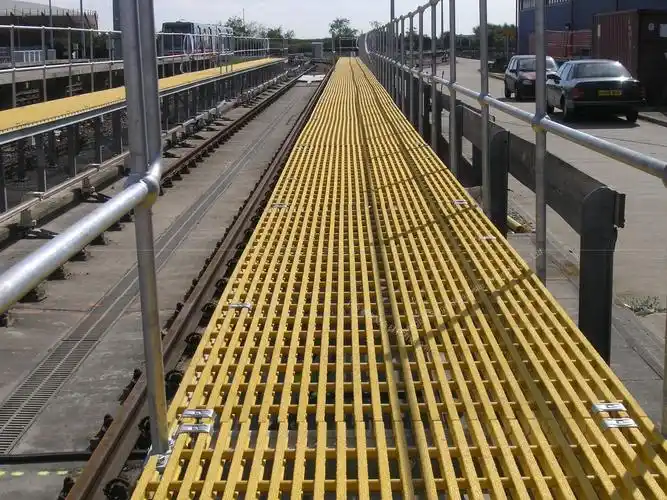Introduction
When it comes to building safe, durable, and low-maintenance infrastructure in challenging industrial environments, fiberglass plastic grating is quickly becoming the material of choice. Unlike traditional steel or aluminum grating, fiberglass plastic grating offers unique benefits that make it an ideal solution for power utilities, civil construction, agriculture, and OEM manufacturers. In this article, we’ll break down the top benefits of this high-performance material and show you why more engineers and procurement managers are choosing it to improve efficiency, reduce costs, and extend service life.

fiberglass plastic grating
What Is Fiberglass Plastic Grating?
Definition and Composition
Fiberglass plastic grating is a structural panel made from fiberglass-reinforced plastic (FRP). The core materials typically include a thermosetting resin—such as polyester, vinyl ester, or phenolic—combined with continuous fiberglass strands. This creates a product that is both strong and corrosion-resistant, without the heavy weight or susceptibility to rust found in metal grating.
There are two main types of manufacturing processes:
Molded grating uses open molds and offers strength in both directions.
Pultruded grating is made by pulling fiberglass and resin through a heated die, producing grating with high unidirectional strength and stiffness.
Common Types of FRP Grating
Molded FRP grating: Best for areas with high corrosion exposure, like chemical plants or wastewater treatment facilities.
Pultruded FRP grating: Used when structural integrity under heavy loads is a priority, such as in manufacturing or shipping facilities.
Top Benefits of Fiberglass Plastic Grating
Superior Corrosion Resistance
Fiberglass plastic grating is chemically resistant, making it ideal for industries that deal with harsh environments. Whether exposed to saltwater, acids, or industrial solvents, this grating will not rust, corrode, or deteriorate the way steel does.
Case Study (anonymized):
A regional wastewater treatment plant replaced their metal walkways with molded fiberglass grating. Over five years, the facility reported a 35% reduction in maintenance costs, with zero downtime due to corrosion-related failures.
Lightweight and Easy to Install
One of the standout benefits is its light weight, which can be up to 60% lighter than steel. This reduces shipping costs and simplifies installation. In many cases, crews can install fiberglass grating without cranes or forklifts.
For retrofits or hard-to-reach locations—such as rooftop platforms or offshore structures—this ease of handling results in significant time and labor savings.
Non-Conductive and Fire-Resistant
Fiberglass grating is naturally non-conductive, making it ideal for electrical environments like transformer yards or data centers. Depending on the resin system used, it can also meet ASTM E84 Class 1 fire ratings.
This means it not only prevents electrical conductivity but also slows fire spread, improving worker safety and regulatory compliance.
Long Service Life and Low Maintenance
With proper resin selection, fiberglass plastic grating offers a service life exceeding 20 years. UV stabilizers prevent sun damage, while anti-slip surface options maintain traction over time.
Because it doesn’t require painting, welding, or coating, the long-term maintenance burden is significantly reduced.
Where Fiberglass Plastic Grating Excels
Industrial and Commercial Applications
The versatility of fiberglass plastic grating makes it a go-to option across multiple industries:
Power utilities: Non-conductive and weather-resistant walkways, trench covers, and platforms.
Food processing: Non-porous surfaces resist bacteria and are easy to clean.
Agriculture: Resists ammonia, manure, and fertilizer exposure in barns and grow houses.
OEM and Custom Design Opportunities
One of the most valuable aspects for manufacturers is the customization potential. Grating can be designed with specific load ratings, resin systems, surface types, and color coding.
Common OEM applications include:
Machine access platforms
Chemical tank covers
Ventilation screen panels
Ladder rungs and structural flooring
Ensuring Product Quality and Compliance
Standards to Look For
To ensure you’re sourcing a quality product, verify compliance with industry standards, such as:
ANSI/ACMA FRP Grating Manual
OSHA slip resistance requirements
ISO 9001-certified manufacturing processes
These certifications reflect the product’s strength, durability, and workplace safety compliance.
Choosing a Reliable Supplier
Not all fiberglass grating is created equal. Look for suppliers that offer:
Technical support for resin and structural decisions
Cut-to-fit services to streamline installation
Full traceability and documentation of materials
“The supplier’s ability to pre-cut and pre-fabricate saved us two weeks of installation time,”
— Senior Project Engineer, Civil Construction Firm
An experienced supplier can help avoid costly mistakes by ensuring the right resin system and load specification for your application.
Conclusion
If your business operates in harsh environments or demands long-lasting infrastructure solutions, fiberglass plastic grating should be on your radar. Its corrosion resistance, safety features, and low maintenance profile make it a smart investment for industrial buyers who value performance, compliance, and ROI.
Want to explore how fiberglass plastic grating can enhance your next project?
👉 [Contact us today] to request a custom quote or consult with our engineering team.
 info@unicomposite.com
info@unicomposite.com


























